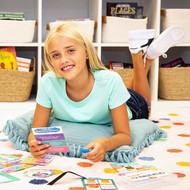6 Ways Teachers Can Incorporate Social Emotional Learning in the Classroom
Posted by Leigh Ann Pernell on Aug 26th 2022
With everything that has taken place over the last two years, it’s no surprise that the effects of the pandemic may have caused increased stressors for young learners both in and out of the classroom, but there is a way to help! I’m sharing tips from my own teaching experience that have helped me incorporate social emotional learning (SEL) into my own classroom to create a learning environment where students feel safe and confident to explore, grow, and succeed—and you can, too!
- Self-Awareness: Mindfulness of one’s feelings, emotions, goals, and values.
- Self-Management: Ability to regulate emotions and make appropriate behavior choices.
- Social Awareness: Understanding, respect, and empathy for others.
- Relationship Skills: Establishing and maintaining healthy relationships and building awareness of how behaviors can affect and influence others.
- Responsible Decision-Making: Developing the skills to make responsible and appropriate choices.

Social emotional learning is a great way to help students interact with others more positively while understanding and controlling their own emotions and feelings in a healthy way. There are so many ways you can incorporate social-emotional learning into your classroom, but we’ve narrowed it down to our six favorite (and effective!) ways to integrate SEL activities in fun and engaging ways for your students.
-

Use quality read-aloud storybooks for teachable moments. There are numerous social emotional learning readers filled with captivating imagery, literary language, and complex themes that will open the door for rich classroom discussions. Children can build self-awareness skills as they make connections between the literature and their life experiences. A well chosen book can also open the door to conversations that address relationship skills and responsible decision making. Diverse literature can also provide the opportunity to build awareness of different cultures and create empathy for others. The sharing of high-quality books and stories not only builds literacy skills, but promotes reflective thinking as children respond to the text and explore social and emotional concepts in a safe environment.
-

Create a positive and inclusive learning environment with SEL décor and visuals. Social emotional classroom décor can be a great way to provide students with visual reminders of classroom expectations, how to communicate with others in a healthy way, make responsible choices, and more. Having a classroom filled with positive messages and visual cues helps students to internalize SEL strategies. The SEL teaching supplies I find most helpful for my classroom include mindfulness posters, learning cards featuring emotions, and educational problem-solving games can help to create a learning environment where students feel safe to explore, discuss, and build positive social and emotional awareness.
- Teach management techniques for dealing with conflict. Something that I have my students practice when they are dealing with conflict amongst one another is the practice of peer meditation. Peer mediation techniques help students build strategies to attack problems, not people. When conflicts arise, guide children in working through the disagreement in a respectful way; let those involved in the conflict have a chance to share their concerns without interruption while the other(s) actively listen. After each side feels heard and understood, lead the students toward creating a solution to the problem. Having the chance to be active problem solvers can be empowering for young learners and helps them to build self-awareness along with relationship skills.
- Practice mindfulness activities—and breaks! Sometimes mindfulness comes from taking a step back and giving yourself the space and room to breathe and reflect. When your students are feeling stressed, overwhelmed, or upset, have them stop what they are doing and focus on their breathing for one minute to help focus their minds and calm their bodies. Stretching is another great physical technique you can practice in the classroom: as students move through their stretches, have them breathe deeply and focus on the feel of their muscles as they slowly move. Mindfulness techniques can help to alleviate stress, bring peace to the classroom during chaotic times, and transition students back to actively listening and learning.
- Hold morning, daily, or weekly class discussions. An important aspect of teaching SEL in the classroom is to make sure that all students feel seen and heard. A great way to do this is to set up class meetings where every student has a voice to discuss what is working and not working in the classroom. These check-ins provide great opportunities for problem solving and responsible decision making as a team, allowing your students to pinpoint problems and come up with steps toward a solution or goal for how to improve a situation together. By inspiring our students to work as a classroom community, we can help our young learners develop relationship skills and see how what they do and say can affect and influence others.
-

Encourage expression through hands-on opportunities and discovery. Set aside time each day for students to explore and create using personal areas of interest. Art, music, engineering, dramatic play, and other activities using manipulatives and social emotional games and worksheets can open the door for exploration, communication, and positive interactions. Giving students a choice can help them to build self-confidence, promote self-management skills, and provide opportunities to make responsible decisions. By giving students the chance to choose some of their learning activities, we help them to build self-awareness as they extend their talents and explore areas they are passionate about.
As we strive to meet the individual needs of our students, we also strive to create an environment where each child feels safe, supported, and valued. By providing social-emotional learning opportunities in the classroom, we help our students develop the skills necessary to manage their emotions, make responsible choices, and establish healthy relationships that can last a lifetime!

